I. N. Burtylev, K. V. Mokhun, Y. V. Bodnya, D. N. Yukhnevich
Department of Computer Science & Software Engineering, Zaporozhye Institute of Economics and Information Technology, Zaporozhye, Ukraine
Correspondence to: I. N. Burtylev, Department of Computer Science & Software Engineering, Zaporozhye Institute of Economics and Information Technology, Zaporozhye, Ukraine.
| Email: |  |
Copyright © 2012 Scientific & Academic Publishing. All Rights Reserved.
Abstract
The article is dedicated to views the advantages of electronic document management systems. It assesses the effectiveness of these systems implementation. The analysis and selection of software tools for the documents management systems development are carried out. The problems and the ire solving with the help of the software implementation in the enterprise are studied. The examples of successfully working systems of electronic document management in certain enterprises are given.
Keywords:
Electronic Document Management System, Software, Turnover of Documents
Cite this paper: I. N. Burtylev, K. V. Mokhun, Y. V. Bodnya, D. N. Yukhnevich, Development of Electronic Document Management Systems: Advantage and Efficiency, Science and Technology, Vol. 3 No. 2A, 2013, pp. 1-9. doi: 10.5923/s.scit.201301.01.
1. Introduction
The introduction of electronic document management systems (EDMS) enables organizations to spend less and earn more. Determination of efficiency is considered as the result of activity achieved, referred to the cost of achieving it[1]. As can be seen, increase the efficiency of the organization may be at least by two ways: by reducing costs and / or increasing the result. Good electronic document management systems can implement both variants.Let’s consider, first, the factors that can reduce costs:§ Reduce the cost of paper documents.§ Reduction of overhead staff time.§ The acceleration of information flows.§ Change the corporate culture. To assess the potential economic impact of the introduction of (EDMS) it is necessary to know what time employees are spending on the performance of routine, unproductive operations on documents. According to estimates by Western consulting companies, the share of such transactions can be up to 20-30% of the total working time[2].Thus, the task of implementing the EDMS is very important to structuring and systematization of existing information and, also, as well, for a successful business organization First of all it is necessary to develop the creation of the EDMS-based direct interaction with people. So, the aim of this article is the creation of specific types of EDMS for companies operating in the fields of trade, services, housing and public utilities and public services, special equipment.
As can be seen, increase the efficiency of the organization may be at least by two ways: by reducing costs and / or increasing the result. Good electronic document management systems can implement both variants.Let’s consider, first, the factors that can reduce costs:§ Reduce the cost of paper documents.§ Reduction of overhead staff time.§ The acceleration of information flows.§ Change the corporate culture. To assess the potential economic impact of the introduction of (EDMS) it is necessary to know what time employees are spending on the performance of routine, unproductive operations on documents. According to estimates by Western consulting companies, the share of such transactions can be up to 20-30% of the total working time[2].Thus, the task of implementing the EDMS is very important to structuring and systematization of existing information and, also, as well, for a successful business organization First of all it is necessary to develop the creation of the EDMS-based direct interaction with people. So, the aim of this article is the creation of specific types of EDMS for companies operating in the fields of trade, services, housing and public utilities and public services, special equipment.
2. General Principles of the EDMS Creation
2.1. The Main Purposes Worked Out by Systems of Document Management
The main advantage of the EDMS is not so much in saving time and supplies, but in a new, more accurate organization of business processes of the company.Implementation of EDMS provides:§ a more effective management because of automatic monitoring of the implementation, transparency throughout the organization at all levels;§ support the quality system in line according to international norms; § support efficient storage, management and access to information and knowledge. Ensuring of personnel flexibility through greater formalization of each employee and the possibility of storing the entire history of its activities has been done;§ logging of the activity of the enterprise in general (internal office investigations, analysis of the activity of the sub-units, identification of "hot spots" in business); § optimization of business processes and automation of their implementation and monitoring mechanism;§ exclusion or maximum reduction of paper documents circulation in the enterprise. Resource savings are held by costs reducing for the document turnover of management within the organization; § exception of necessity or substantial simplification and cheaper storage of paper documents with an operational electronic archive.There is a significant reduction in the time of individual stages of work the under condition of paper-based processes replacing (Fig. 2.1) by digital (Fig. 2.2)[3]. 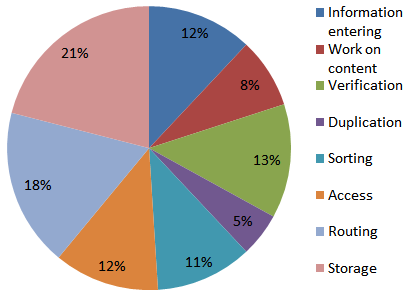 | Figure 2.1. Paper Document Management |
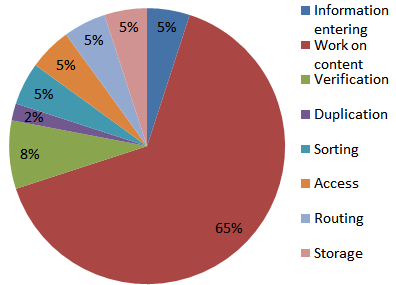 | Figure 2.2. Electronic Document Management |
2.2. Problems and Solutions in EDMS Implementation
During EDMS implementation phase there are often such common problems:§ Staff's conservatism, low level of education, unwillingness to train and re-train. Top management staff's fear of own activity transparency, which occurs after the introduction of electronic document management systems. § Management factor - unwillingness to work directly with computer, to view and edit documents. § Permanent structural changes in the organization, weak of formalization of business processes. § Necessity for a providing legal force of documents (after the adoption of the law about electronic signature, this factor will lose its significance). § Necessity to communicate with the external "paper" world, especially when it refers to parallel structures in associated organizations or agencies with which there is a constant work.Despite the problems of implementation, said above, EMDS are becoming more widely used, precisely because their effect is measured not by the direct resources saving, but by the improvement of organization’s quality of work.To overcome the common problems of EDMS implementation one should follow such methods:1. Make the transition to electronic document management system gradual. For example, at first you can implement only electronic mail.2. Find supporters-enthusiasts who will help "catch-up" employees to learn a new paperless technology at the stage of preparatory work.3. Explain the benefits of the implementation to managers of any type and make them staunch supporters of electronic document management system introduction. 4. Paper documents from the outside world should get into the internal electronic document management system, for that purpose in EDMS it's necessary to receive their electronic variants. 5. Use the existing instruments to create new ones. If it is expected that the work will be carried out continuously, it is best to provide the server and text recognition (for a full-text search), and workplace installed recognition. In this case, the user will have the opportunity to convert images to text documents with necessary options, and save them in the necessary format by himself.6. If your organization has a paper archive of documents, the electronic archive can be filled by these paper documents scanning.7. If an organization has no achieve, first you should create a common means of documents storage in directories and prohibit (including, if possible, by technical means) storing documents on PC's local disks.
2.3. External Electronic Documents Management
The problem of interchanging correspondence between organizations using different electronic document management systems is very important.The introduction of digital signature partly solved this problem permitted paperless document interchange between independent organizations. However, the lack of unified standards for the electronic correspondence interchange is a serious obstacle to the practical realization of this possibility.1. The release of a new XML-format[4], which one of the most promising options is the transition to unified system of electronic document management, will significantly increase the effectiveness of organizations' contacts with partners, remote branch offices, government bodies and other external organizations..
2.4. Globally Distributed Information Systems
In the world there is a huge number of ready-to-use information resources. They were created in different times, and different approaches were used for their development[?]. Almost always, suitable by their functions already working components can be found at the development of a new information system. The problem is that the requirements of interoperability were not taken into consideration while their development. These components do not understand one another, they cannot work together. It is desirable to have a mechanism or set of mechanisms that will make such independently developed information-computational resources be interoperable.The first step in solving the problem of information resources integration was an attempt to create the means, which allow to integrate a set of heterogeneous databases (hierarchical, network, relational and so on). Known approaches were based on the use of a relational data model as an unified model (Fig. 2.3). | Figure 2.3. Typical functions of EDMS |
These means were able to work with heterogeneous databases in an unitary conceptual data model[5].
2.5. The Lifecycle of the Document
Any document, regardless of its structure or content goes through a number of stages, which are generally named "document lifecycle". All documents go through five stages of the lifecycle (some steps may be repeated, and some occur only once):1) documents are created;2) they are reviewed and corrected;3) formally or informally approved;4) distributed or published for a wider audience;5) they fulfill their main purpose and get to the archive;6) if necessary, they are retrieved from the archive, and then archived again.In record-keeping groups of documents are usually distinguished as incoming, outgoing, internal, organizational and regulatory. Such division, as a rule, remains when working in the electronic document management system. At the stage of creating (in this case getting a document by an electronic document management system from external systems) it requires the most time consuming part of the work by entering the information about the document in the electronic document management system.This work consists of two parts:1) Enter the details of the document;2) Enter the document image.To save time in EDMS there is such a service as a document creation according to the pattern. Pattern is a certain kind of blank document, where you can include all of the repetitive elements.Patterns can be of two types• "blank" in the form of a file from one of the Office applications. Pattern opens in the "home" application, and further work is going on there;• the text which can be viewed directly in the registration and control document record.The first variant of patterns is more convenient to apply when an organization uses a mixed type of electronic document management: some document processing operations performed in EDMS, and a part in "live" with the use of document paper copies[6].The second variant is more convenient when work with documents completely goes to the jurisdiction of EDMS. For example, the order for personnel pattern is easier to do in a WORD file, as it will be to printed for a long term storage. The second type of pattern may be used for domestic orders and directions as well[7].
3. Development of ECD on Concrete Enterprises
3.1. Tools And Development Environment
There are different standards for electronic document management systems. In the USA the main standard is the DoD, in the European Union – MoReq[8]. Compared with practical DoD, MoReq designed in a more formal, "scientific" style and from a greater number of topics.A significant drawback is the fact that there is no certification program MoReq, and while the line it is not mandatory.Workflow software is, as a rule, the application architecture "client - server" or using the WEB - technology and XML. In any case, the system includes:§ DBMS server;§ WEB - server (for systems using WEB - technology);§ The server part of the system;§ The file server (usually in different systems implementation is different, but generally, you need software to interact with the data warehouse);§ Client side.Required tasks that should provide any electronic document management system - is to work directly with a registration card, execution control, input and output of documents, search for them and the organization of secure network connection is.The following is a detailed classification system functions for which the comparative analysis of workflow systems (Fig. 3.1). | Figure 3.1. Instrumentation Model EDMS |
We will enumerate the basic functions of SOFTWARE:§ Providing of rights for access to information, according to the real structure of enterprise.§ Providing of input of any documents of enterprise in a single database with establishment of card of document and placing of file in one or another area of storage.§ Providing the reflection of structure of wares.§ Providing of reflection of logical connections between the files of the documents created in different applications. Thus a document has one registration record and card.§ Providing of really existent logical connections of documents belonging to the different streams of information. For example, a letter coming an administrative or "office" stream to the secretary can have logical connection with engineer-designer documentation. Such connection can be represented, and the file of letter is "added" to the drawing (drafts) file.§ Providing of logical association of all documentation, regardless of stream, in a folder or division of archive, belonging, for example, to one good, project.§ Providing of co-operating with all subsystems of complex decision is the systems of electronic archive and circulation of documents. The system provides co-operating with the devices of scan-out, circulating, storage and user applications accepted for work with the documents of any streams on an enterprise.§ Providing of search on by the set or formed user of queries of any document.§ Providing the co-operation between users by means of the embedded system of e-mail with possibility of distribution of reports and inlaid documents.§ Providing the «status» of documents.§ Providing of support of different versions.§ Providing of signature of document. The system has the embedded system of electronic signature. Information about a person, signing a document, to the date, oneself is registered time of signature in the system.§ Providing document routing. The system allows to plan routes, specify it in the handling of the registration of the new document.§ Providing the reporting system.Thus, the demand for such programs is growing rapidly and through this manufacturers are creating more and more sophisticated, multi-functional system to resolve any industrial issues.Modern software development tools are characterized by a large variety of criteria, using which the developer has the ability to automate the process of application development. Thus, at present the tools allow to:§ Create the interface using standard components.§ Transfer control to different processes, depending on the state of the system.§ Create a shell for databases, as well as strictly speaking the database.§ Develop more reliable Software by handling exceptional situations occur while incorrect operation software.Modern development tools are characterized by the following parameters:§ Support for object-oriented programming style.Ability to use CASE-technologies, such as for the design of the system under development, and to develop models of relational databases.§ Use of visual components for graphic interface design.§ Support database.§ The ability to use relational algebra algorithms for relational database management.§ Ability to synchronize the components of the project (subject to the development of large software systems).The above properties have high-level programming languages.Table 3.1. Characteristics of the development environment
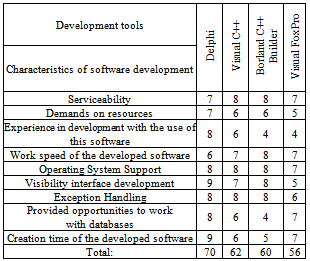 |
| |
|
To select the development environment use the variant justifications method. This method is designed to select the best option and consists of the following stages:§ Defining criteria for which comparison and the degree of importance will be performed.§ Each variant is assessed on the resulting list of criteria. A numeric value is an assessment.§ Finding the total number of points for each of the variants (you can consider the importance of the criteria.)§ The best is the variant, that gets as many points.To solve this problem we use a list of characteristics are listed in table 3.1.[9].
3.2. Example of the EDMS in the Service of Housing and Household Services
As an example of the EDMS at "Vodokanal" - Water management authority (Zaporozhye, Ukraine) a system of “Registration and calculation of instrumentation” was implemented. Fig. 3.2 shows the main program window.Software development environment was selected Borland C + + Builder Version 6.0, that provides high quality code throughout the software development life cycle, from design to development.Also in the Borland C + + Builder Version 6.0 was included component EhLib 5.6 which is also involved in the development of the software.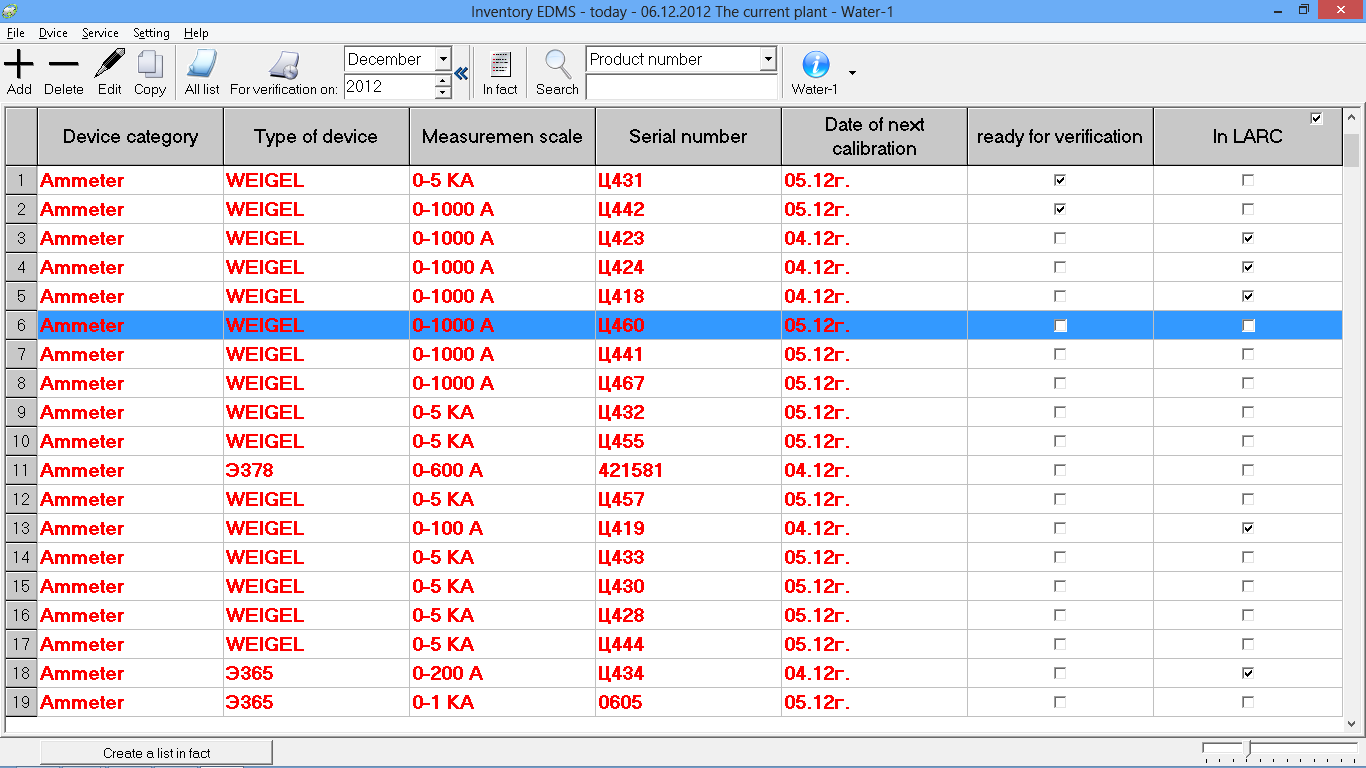 | Figure 3.2. The main program window of the “Registration and calculation of instrumentation”system |
EhLib 5.6 contains components and classes for Borland Delphi 5-8, 2005, 2006, C + + Builder 5-6, CodeGear Delphi 2007, CodeGear RAD Studio 2009, Embarcadero RAD Studio 2010, XE and RAD Studio XE2, and seeks to empower the front end database, when the user interacts with the application.After the introduction of the system it become convenient to view and edit the information on a specific instrumentation (Fig. 3.3).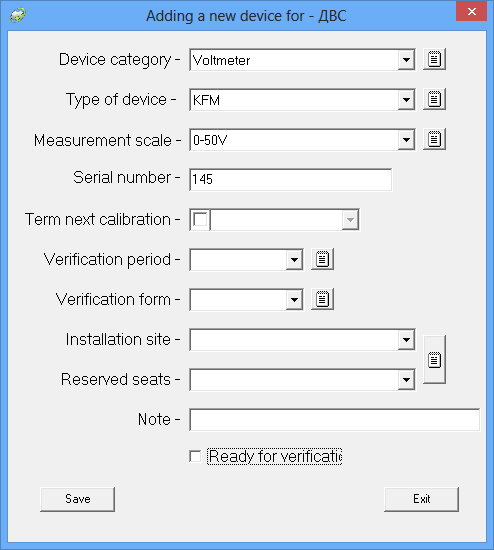 | Figure 3.3. The information on instrumentation |
The search for the required device became fast and convenient, it is possible clarification of its location on the territory of the enterprise. The software in time informs the user to replace, remove to verificate of some devices. Automatically generates an electronic document with the name of devices that have approached term verification. The need for paper records of the movement of the location of the device on the enterprise was eliminated.Using electronic documents in the system, in the company "Vodokanal" it became possible to structure the stock control instrumentation, efficient use of staff time to search for and removal of the necessary instruments for mandatory verification. Thereby the quality of treated wastewater was improved, what favorably affected the environment.
3.3. Example of the EDMS in the Field of Trade
As an example of the EDMS in the company Ltd. "TransLis" (Zaporozhye, Ukraine) there was introduced the system of "Accounting document." Fig. 3.4 shows the main program window. | Figure 3.4. The main program window of the system Accounting document |
For the tools there was used development environment Delphi, programming language Object Pascal.The advantages of this EDMS are:§ the order quickly location (Fig. 3.5)§ exception information leakage;§ reduce the cost of paper documents;§ saving staff time;§ automatic counting the amount of supply, provided > 1 order;§ risk of loss of documents was reduced;§ improving performance discipline;§ acceleration of information flows;§ increasing the quality of information;§ significant acceleration of sample documents on various attributes (Fig. 3.6);§ creation of a unified information space across distributed organizations;§ the most efficient use of the software that is already installed in the company;§ error in the date order will never happen (as in the software there is a special calendar).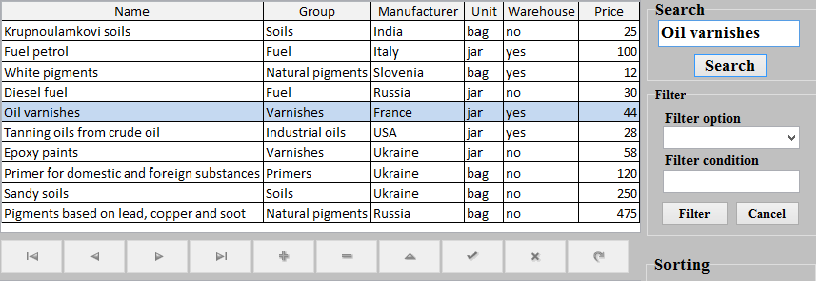 | Figure 3.5. Result of the function "Search" |
 | Figure 3.6. Filter option |
After implementation of the software for document management some tasks became unclaimed, such as:§ logging orders;§ archives;§ process of committing order information from hand to hand.
3.4. Example of the EDMS in Inventory
As an example of the EDMS at the firm "Booklet" (Zaporozhye, Ukraine) there was implemented a system of "Warehouse account printed products in a book store." Fig. 3.7 shows the main program window. | Figure 3.7. The main program window of a system “Warehouse account” |
To write a program the programming language C # programming environment Microsoft Visual Studio were selected.Proposal Software allows quickly finding, viewing and editing information about any book (Fig. 3.8).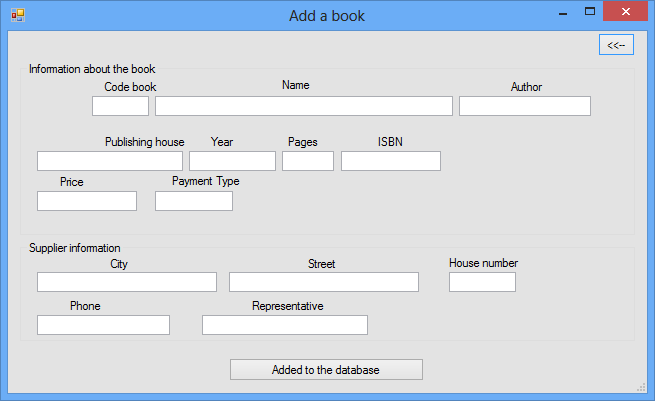 | Figure 3.8. Window editing the book |
Before the introduction of the EDMS one of the problems at the company were a large amount of information and spending a lot of time searching for the information. After implementation of the EDMS time searching and sorting has declined significantly.
3.5. Example of Document Management System in the Area of Inventory Control
As an example of the SED, a "household inventory and digital technology accounting at the store of electronics" was implemented in the firm "Q-Tech" (Zaporozhye, Ukraine). Figure 3.9 shows the main program window.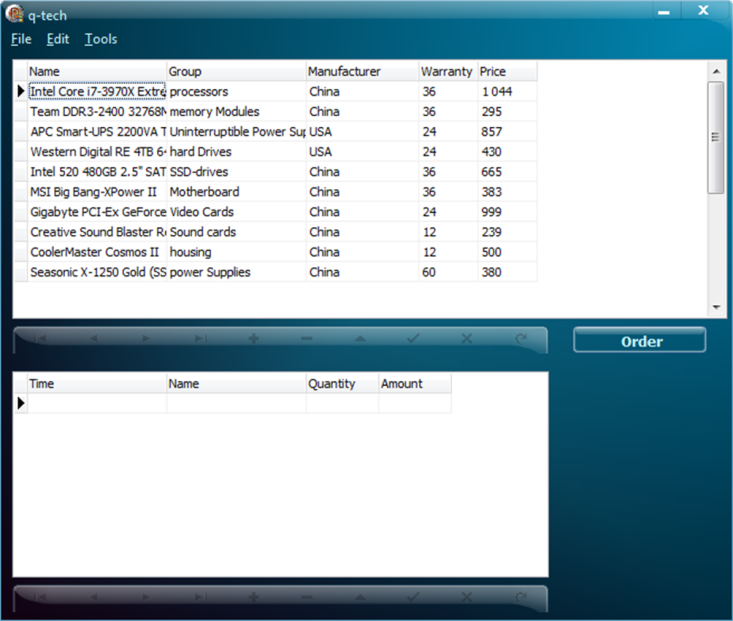 | Figure 3.9. The main window of "Product accounting" |
For the performance, Delphi development environment and Object Pascal programming language were used.This software helps to speed up the work on the product data, to add them to the database. The advantages of this program are:§ friendly interface;§ quick search;§ no data loss;§ reduced costs of time;§ limited access.
4. Conclusions
Arrangement of electronic documents provides significant economic benefits to the enterprise, but its quantitative assessment is a complicated process, as you have to consider many factors. The economic effect is largely determined by the correct choice of the system and the process of implementation.It is very important to choose the right system and not to compromise on the implementation process. The price of the system is primarily determined by its affiliation to the particular class. Duration of the implementation process depends on the complexity of the system and can range from one week to a year or more.There are other, equally important benefits which the automation system would provide. These benefits are not always explicit, but they certainly also affect the effectiveness of the organization as a whole - the level of staff training and ambitions of employees increase, the use of modern information technologies is acculturated.
References
| [1] | O'Sullivan, Steven M Sheffrin, Economics. Principles in action, Needham, Mass.: Prentice Hall, 2003. |
| [2] | David H. Maister, Managing the Professional Service Firm, Simon & Schuster, 1993. |
| [3] | Dolin A. P., Exploring Digital Workflow, Thomson Delmar Learning, 2006. |
| [4] | Simon St. Laurent, XML Elements of Style, McGraw-Hill Companies, 2009. |
| [5] | Menne-Haritz A., Dokumentenverwaltung systeme und offentliche Verwaltung: Wo ist der Sand im Oetriebe. Deutschcr Dokumentartag, Proceedings DGD, 1994. |
| [6] | Koulopoulos Thomas M., Frappaolo Carl. Electronic Document Management Systems: A Portable Consultant, McGraw-Hill Book Company, 1994. |
| [7] | Online Available:http://www.documentmanagement.org.uk/articles/EDMSCompUses.htm. |
| [8] | Model Requirements for the Management of Electronic Records: Moreq Specification (INSAR supplement), Office for Official Publications of the European Communities, 2002. |
| [9] | Galchenko V.G., System Programming with WIN32. Creating a Windows application, Tomsk: TPU, 2009. |

 As can be seen, increase the efficiency of the organization may be at least by two ways: by reducing costs and / or increasing the result. Good electronic document management systems can implement both variants.Let’s consider, first, the factors that can reduce costs:§ Reduce the cost of paper documents.§ Reduction of overhead staff time.§ The acceleration of information flows.§ Change the corporate culture. To assess the potential economic impact of the introduction of (EDMS) it is necessary to know what time employees are spending on the performance of routine, unproductive operations on documents. According to estimates by Western consulting companies, the share of such transactions can be up to 20-30% of the total working time[2].Thus, the task of implementing the EDMS is very important to structuring and systematization of existing information and, also, as well, for a successful business organization First of all it is necessary to develop the creation of the EDMS-based direct interaction with people. So, the aim of this article is the creation of specific types of EDMS for companies operating in the fields of trade, services, housing and public utilities and public services, special equipment.
As can be seen, increase the efficiency of the organization may be at least by two ways: by reducing costs and / or increasing the result. Good electronic document management systems can implement both variants.Let’s consider, first, the factors that can reduce costs:§ Reduce the cost of paper documents.§ Reduction of overhead staff time.§ The acceleration of information flows.§ Change the corporate culture. To assess the potential economic impact of the introduction of (EDMS) it is necessary to know what time employees are spending on the performance of routine, unproductive operations on documents. According to estimates by Western consulting companies, the share of such transactions can be up to 20-30% of the total working time[2].Thus, the task of implementing the EDMS is very important to structuring and systematization of existing information and, also, as well, for a successful business organization First of all it is necessary to develop the creation of the EDMS-based direct interaction with people. So, the aim of this article is the creation of specific types of EDMS for companies operating in the fields of trade, services, housing and public utilities and public services, special equipment.











 Abstract
Abstract Reference
Reference Full-Text PDF
Full-Text PDF Full-text HTML
Full-text HTML